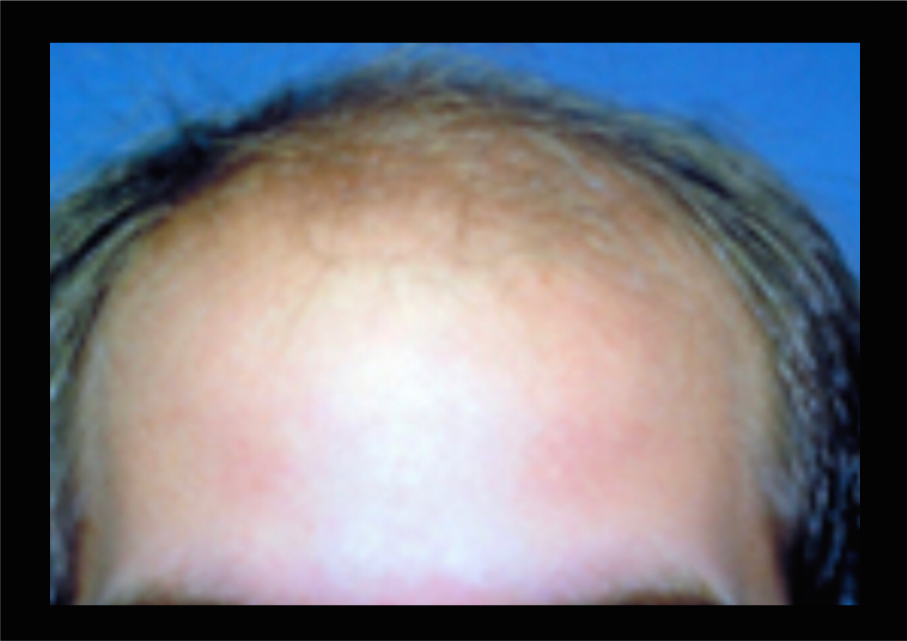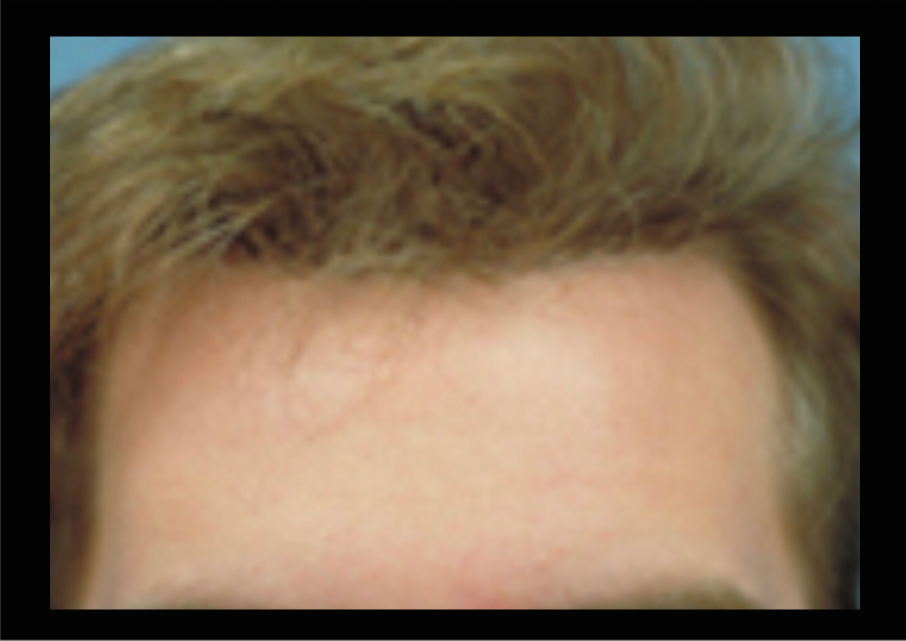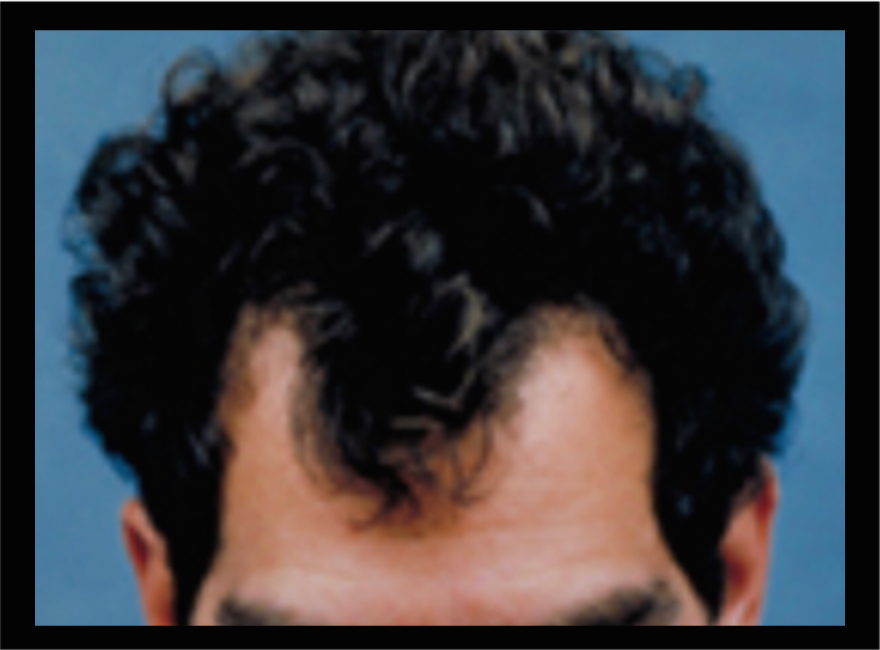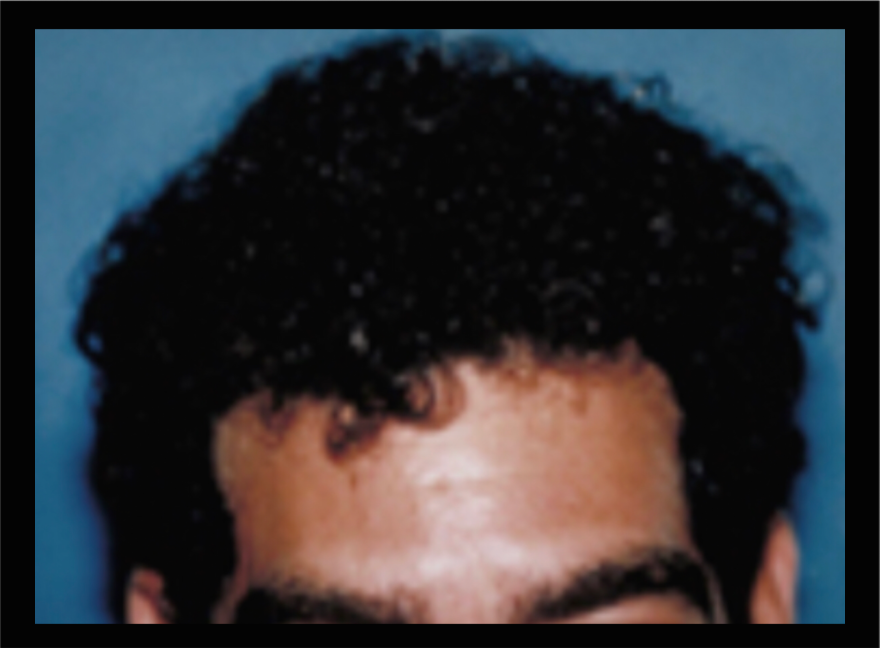
Summary
“Purpose (Indications)“
Hair loss
Thinning or receding hairline
Hair loss secondary to injury
“What It Does“
Redistributes hair from occiput (back of head) to the balding or thinning areas
Provides more natural appearance
Allows more athletic activities without the need to modify activity because of hair piece, toupee, or or other artificial ways
“Technique“
Thin strip of hair is removed from occipital area of scalp & moved or transplanted to non-hairbearing areas where it continues to grow permanantly
Strip is contoured into individual donor hair or groups of hair follicles
Small clips used to close incisions in hair
“Recovery Time“
1-7 days until able to return to work in most cases, depending upon the type of hair loss and number of grafts
“Recovery Instructions“
Turban like dressing applied overnight and removed the following morning
No heavy lifting or straining for 1-2 weeks
Sleep with head elevated for two weeks
Clean area of new hair grafts four times a day for week
“Ancillary Procedures Commonly Performed In Conjunction With A Hair Transplant“
Facelift surgery
Blepharoplasty
Nasal surgery
Neck lift surgery
Skin rejuvenation procedures
More Information
Creeping hairlines and thinning hair have become commonplace with both men and women – even in their twenties and thirties. In fact, 2 out of every 3 adult men and approximately 20% of women experience balding or thinning to the point that they have considered seeking treatment.
How you see yourself, and how others see you, are very important ingredients for success. Some accept hair loss as a course of nature, but for others it is a distressing condition. Unfortunately, treatments with medications, massage, or therapeutic appliances in the hopes of obtaining hair growth are often frustrating, expensive, and usually useless.
Advances over the past few years have made it possible to shrink wide bald spots, add hair to sparse areas, and create new, natural-looking hairlines.
To date, the most successful method of correcting baldness is to transfer the patient’s own hair from non-bald areas to the areas of hair loss. The procedure for treating baldness might well be more accurately termed “hair redistribution”. This can frequently lead to dramatic results. The results of today’s surgical hair restoration techniques are usually permanent and can be extraordinary. However, treatment often involves multiple visits, and it may take several months to realize the true results. While improvement is often very gratifying, the patient considering hair transplantation should realize that he or she will never be able to obtain a full head of hair comparable to their pre-balding condition.
Today, many individuals wish to take action at an earlier age and stay ahead of their beginning hair loss by adding fullness and density to thinning areas a little at a time. This results in the grafts being virtually undetectable. One is able to camouflage the newly growing transplanted hairs with their existing hair. This enables one to allow the newly growing transplanted hair to stay subtle and unobtrusive between procedures. This is increasingly important to many individuals, but especially to the growing number of individuals from high-profile business, professional, political, and entertainment fields.
Most patients desire a very natural look. For some, it is a desire to have a thickening of thinning areas subtly over the course of several procedures. On the other hand, some individuals are seeking to have a hairline recreated on a balding scalp. For these individuals, the new advanced techniques allow a more natural look with low visibility graft patterns that replace the traditional “row structure” or “cornstalk” look associated with older hair transplantation techniques.
We have all heard people comment that they have not seen “any good-looking hair transplants”. They state that the only hair transplants they see are “obvious” and look “pluggy”. We have all seen men with hair transplants that look like dolls’ hair or rows of corn in the front. Fortunately, there have been tremendous advances in the field of hair restoration. Today, we are able to create more natural-appearing hairlines that decrease the visibility and detectability of hair transplantation. It is an ironic fact that the better the hair restoration technique, the less people notice. This is what we strive for. However, it does mean that probably only a hair restoration expert might be able to detect their transplants. For this reason, most people only notice the bad hair transplant results and, therefore, there is still a common misperception that this is the typical type of result that is achieved with modern hair restoration techniques. Nothing could be further from the truth.
While individual results may vary and no one can guarantee results, most individuals find that hair restoration provides them with an overwhelming sense of freedom. They are free from the hassle and expense of wearing wigs or using various hair growth lotions. They no longer need to worry about athletic activities, water, sun, or perspiration exposing their hair loss or damaging their hairpiece. They feel that it free them from the physical and psychological barriers that hair loss can create.
“Classification of Hair Loss“

There are seven classifications of baldness, with Class I being normal hair growth and Class VII being the typical horseshoe-shaped baldness. Less than 30% of individuals who have significant hair loss proceed to the Class VII type of baldness. The best indication of whether someone will proceed to that extent is to look at the individual’s father and/or grandfather, since there is a hereditary tendency. It should be noted that individuals will not lose the hair in the posterior occipital area. Hairs taken from this area can be transplanted to the frontal area, and they continue to grow, despite hair loss in other areas.
These individuals have no appreciable hair loss. They are not candidates for surgical hair restoration or artificial hairpieces. If individuals start to experience early hair loss, they may desire to seek drug therapy in the effort to prevent some future hair loss. This will be effective in a very small percentage of men.
These individuals experience early hair loss in the frontal temporal areas which can become severe in future years. These individuals may desire hair transplantation early in order to avoid detectability and negate adverse effects of advancing hair loss. Not all are candidates and this is determined at the consultation, taking into consideration the patient’s age, family history, amount of hair loss, and the type and texture of one’s hair.
These individuals have a more advanced stage of hair loss with thinning in the frontal temporal areas, which is more advanced than Class II. In more advanced stages, there can be thinning or even balding on the crown of the scalp. In most cases, these individuals are excellent candidates for hair restoration, utilizing mini- and micro-graft techniques.
Men with Class IV hair loss have significant hair loss, which results in severe frontal temporal recession. There are enlarging areas of hair loss on the crown area, which results in a “bald spot.” These individuals may use an artificial hairpiece or may choose to proceed with hair restoration to create a more natural frontal hairline. In some cases, grafts or scalp reduction techniques can be used to treat the “bald spot” on the crown area of the scalp.
Class V hair loss is very significant hair loss in the frontal area. In early stages, there can be a “bridge” of hair between the bald area on the crown of the scalp and the frontal area. However, this usually thins very quickly and results in the early stages of the so-called “horseshoe-shaped” baldness. Artificial hair transplants may be utilized by some individuals. Other may choose a more natural, permanent restoration utilizing hair transplantation independently or in combination with scalp reduction. In some cases, individuals prefer to have just the frontal hairline and frontal scalp area restored, leaving a bald area on the crown. In other instances, they desire to have all areas treated. The doctor will be able to determine whether or not an individual in Class V is a candidate for hair restoration utilizing these procedures. This is based upon the patient’s age, family history, amount of hair loss, type and texture of hair, and the amount of donor hair available.
Men with Class VI hair loss have very severe balding. There is significant hair loss in the frontal area with balding on the crown of the scalp. These individuals may choose to utilize artificial hairpieces. Others may be candidates for hair restoration utilizing hair transplantation techniques alone or possibly in combination with scalp reduction, which removes portions of the bald scalp. This allows a small number of hair grafts to more effectively cover larger areas. Again, it is important for men in the Class VI hair loss stage to be thoroughly evaluated to determine whether or not they are a candidate for hair restoration procedures.
Men in Class VII have the most advanced stage of hair loss and typically have the “horseshoe” shaped appearance with a thin band of hair around the perimeter of the scalp. These individuals are not candidates for surgical hair restoration techniques. However, they are excellent candidates for artificial hairpieces.
“Treatment Options Medications”

To date, there is no medication that is uniformly effective in stimulating hair growth. There are a variety of medications that are approved by the U.S. Food and Drug Administration for either application to the scalp or for oral ingestion. The appropriateness of these being prescribed for you can be discussed with the doctor at your consultation.
In general, topical medication has been shown in clinical studies to be effective in approximately 8% of individuals. It usually needs to be applied twice daily. It appears to be most effective for stimulating growth in the crown area of the scalp and has little effect in stimulating hair growth in the frontal areas. In our experience, these have been the areas that have been of most concern to patients and the area in which they most desire to have hair growth. To day, no study has been published that proves that the topical medications have an ability to regenerate hairs along the frontal hairline – the area of greatest concern to most men. There is some indication, although no clinical proof, that while not stimulating new hair growth, the topical medication may help to “slow down” further hair loss in a very small percentage of men. In our experience, the chance of topical medications stimulating hair growth has a direct correlation with the patient’s age and the amount of hair loss. Individuals who have the greatest chance of benefiting from topical medical applications tend to be men in the 20’s or 30’s who have a balding or thinning area on the crown of the scalp, which is approximately 2″ or less in diameter and which has been present for less than 10 years.
In selected cases, we may prescribe either topical or oral medication to use in conjunction with hair restoration in the hopes of accelerating the hair restoration process. However, this is based upon an individual assessment and on the patient’s age, family history, amount of hair loss, type and texture of hair, amount and quantity of donor hair, and medical history.
“Artificial Hairpieces“
Artificial hairpieces are prostheses that a manufactured from either synthetic fibers such a nylon or acrylic or from severed human hair. The main difference between today’s “wigs”, “hairpieces”, “toupees”, and “appliances” and those of the 1800’s have to do with the size and manner in which they attach to the scalp. The traditional way to attach a wig to the scalp was with glue or tape. Unfortunately, the wig could easily become dislodged and create an embarrassment. Today, wig manufacturers have developed different methods of attachment. Some wigs are attached by actual wire loops that are surgically stitched into the scalp. While the wig is not easily dislodged, there is a potential for serious infection, not to mention uncleanliness and potential odor that can occur. Some wig manufacturers have utilized synthetic fibers that hook directly into the scalp. These “implants” have been outlawed in most states because of the potential for severe infection and reaction that has occurred.
Some wig makers utilize a “hair weaving” technique. The wig is made up of severed human hair, which is fastened into a filmy netting that is, in turn, tied tightly to the client’s remaining natural hair. One problem associated with this technique is that the client often experiences additional permanent hair loss due to the frequent tightening or tension on the hair used to secure the wig (traction alopecia). In addition, because natural hair grows at approximately one-half inch per month, there is a continued loosening effect, and the individual needs to continually return at approximately six-week intervals to have the wig “tightened”.
Artificial hairpieces can be expensive. It is important to find out the total initial cost of one wig and the cost of ongoing maintenance. What most individuals do not realize is that you usually need to buy at least two wigs – one to wear while the other is periodically being cleaned and refurbished. When one considers the cost of the average-to-excellent quality wig and the normal usability span of less than two years per “hairpiece”, the lifetime cost of wigs is sizeable. In most cases, the cost of utilizing a wig is comparable to, or exceeds, that of hair transplantation surgery.
Probably the biggest drawback to utilizing hairpieces relates to water-related and perspiration-related activities. While many wig advertisements promote the fact that a man can swim and shower with his wig on, the fact is that this activity usually causes the wig to deteriorate more quickly. One needs to ask if swimming or showering will realistically affect the color and styling of the wig, and if damage will be caused by exposure to soap, water, salt, and chlorine.
To keep wigs looking presentable, they must be of high quality and be carefully and expertly maintained.
“Surgery“
For most men, surgery is the most effective way in which to provide permanent hair restoration. This may utilize hair transplantation techniques where hair is taken from the posterior (occipital) area of the scalp and moved or “transplanted” to non-hairbearing areas where it continues to grow permanently. In other cases, bald areas can actually be removed with an excision technique to actually eliminate the area of baldness or to greatly reduce its size, making it more effective to camouflage the area of hair loss with hair grafts. In unusual cases of hair loss, flaps of hair-bearing skin can be rotated to cover balding areas.
“Hair Transplantation: Why It Works“
For centuries, doctors could not determine why even the most severely bald men still had a horseshoe-shaped rim of permanent hair along the sides and the back of the head. In the mid-1950’s, it was theorized that hairs in this area were genetically programmed to resist the withering effects of male hormones which could cause hair loss. Along with this came the theory of “donor dominance”, which means that the genetic characteristics of hair in this area are that it will continue to grow if donor hairs are transplanted into areas of thinning or balding along the front and top of the head where non-permanent hairs had previously withered away from the effects of male hormones.
Essentially, hair transplantation involves removing portions of the skin that contain hair follicles, removing bald areas, and replacing the bald areas with the new hair grafts.
It is important to note that every single follicle on the human scalp is genetically programmed before birth to either become sensitive to male hormones when we begin to go through puberty or to have a permanent resistance. Those that are sensitive to male hormones wither away and die after a certain period of time. Those that are non-resistant continue to grow for a man’s entire life.
Men with male pattern baldness have areas in the back of the scalp, or occipital area as it is termed medically, where hairs are noted to be hormone-resistant – the so-called “donor area”. Hair transplantation uses the excess permanent hairs from this donor area and relocates or “transplants” the hairs to areas of thinning and balding on the top or front of the head.
“Creating a Natural Look“
The “art” of hair transplantation and the critical aspect of obtaining a natural-looking hairline is to design a hairline zone that is correct for the shape of the face, facial features, and one’s age. It is also important to note that the hairline is not actually a true “line”. Rather, the hairline is actually a zone that contains many, delicate hairs that blend softly into the forehead area. It is actually an almost undetectable transition zone from bare skin to thicker scalp hair.
In order to create a natural hairline zone and a natural-appearing transplantation, it is important to utilize extremely fine grafts consisting of one or two hairs, and blending them into grafts containing more hairs in order to create this subtle “transition zone”. By choosing hairs of varying thickness from the donor area and angling them so that they grow in their natural direction, we are able to take a sparse, thinning head of frontal hair and change it into a dense weave of thicker hair packaged tightly together to maximize the appearance of fullness and density. This results in a very natural appearance. Based upon the amount of hair loss, multiple transplantation sessions may be necessary in order to blend and thicken the hair in order to achieve the most desirable aesthetic appearance.
A common mistake made by inexperienced physicians is to design a hairline that is too low on the forehead. As we age, our hairline gradually moves higher. For that reason, to give a 40-year old man the hairline of a 20-year old would result in an unnatural appearance that would become even more noticeable with time. It is important to have a hairline zone with a shape and location that is commensurate with that of a non-balding man your age and one that will be appropriate for your facial shape as time progresses.
“Technique“
Hair transplant surgery is usually done on an outpatient basis. Because it is simply involving removal of bald areas of scalp and transplanting some grafts of skin containing hair follicles, it is usually considered a minor surgical procedure. Surgery is performed in the surgical suite. While most individuals have “twilight” anesthesia, the procedure can be done entirely under local anesthetic.
Individuals wash their hair prior to surgery with a mild antibiotic shampoo. After the patient is properly sedated and anesthetized, a linear strip of hair is removed with special instruments from the posterior, or occipital, portion of the scalp. Harvesting of excess hairs from the transplant donor area in the very back or along the sides of the head can be done in such a way that, in most cases, it is very difficult to detect where grafts have been taken from. The technique we utilize minimizes the amount of scarring and detectability as well as minimizing the waste of precious donor hair. After removing the strip of hair, the edges are closed with special sutures, which leave only one or two faint lines that are immediately covered by the surrounding hair. This technique is not only cosmetically beneficial, it also maximizes the number of hair grafts available as compared to old-fashioned techniques.
Utilizing special instrumentation and magnification, small grafts are created, consisting of 1-2 hair micrografts and 2-6 minigrafts. Special instruments are then used to remove the balding skin. The newly created grafts are then positioned in the new recipient site and positioned precisely to grow together at the angle and in the direction that closely restores your original hair pattern. This results in hair restoration that is specifically customized for you. By creating a gradual transition zone with 1-2 hair grafts and gradually moving into larger grafts, a very natural hairline is created.
After a brief resting period, the transplanted hair in the new hair zone begins to grow and will continue to grow for the rest of your life. It has been said that hair transplantation is an investment that keeps growing!
Following surgery, your hair is washed and bandages placed over the area to secure the grafts in place. A stocking cap is then placed to camouflage and secure the dressing in place. The patient then goes to the recovery area and is released. Patients can remain in the Center overnight in our recovery area facility or can return home. They are seen in the Center the next day for a dressing change. Most individuals find that they are able to resume their normal activities with 3-4 days. For the first 7-10 days, the newly grafted areas are cleaned with hydrogen peroxide and frequent showering.
After approximately eight weeks, the transplanted hairs fall out to make room for the new hairs, which are emerging from the newly transplanted roots. This follows each of the hair transplant procedures and should cause no alarm. This process is similar to a young child shedding his primary or “baby” teeth in order to make room for the adult teeth. At any given time, the scalp contains hairs of many different ages. Beginning the day we are born, the hair undergoes a normal shedding process, whereby an existing hair falls out and new hair replaces it. The transplantation procedure produces a “shock” to the roots of the graft so that, after approximately eight weeks, all the hair in the graft will gradually fall out to make room for the new hairs. In very rare circumstances, hair in the grafts continue to grow and do not fall out. However, this is the exception rather than the rule.
Once new hairs from the transplant graft reach the surface of the skin, they usually grow at approximately one-half inch per month. Male hair needs to be approximately 1-1/2 inches long before it can be appropriately styled. Thus, it takes approximately 4-6 months before we obtain the final aesthetic result from a graft. We usually wait approximately 3-4 months between hair transplant sessions in order to allow the transplanted grafts to obtain a good blood supply and to be able to identify the new growth in order to most effectively place additional grafts.
It is important to note that multiple procedures may be necessary in order to obtain the most desired result. Some of our patients who consider themselves “perfectionists” want to have additional blending and thickening procedures behind the frontal hairline in order to achieve the maximum density possible. Individuals can even obtain additional “softening” of the frontal hairline with additional micrografts. All of this depends upon the patient’s individual desires as well as their hair type, texture, and amount and quality of donor hair available.
“Scalp Reduction: Reducing the Bald Spot“
Men who have an advanced Class IV, as well as Class V and Class VI male pattern baldness, can often benefit from a surgical procedure to reduce the amount of balding skin.
This is called a scalp reduction. It is done under twilight anesthesia or local infiltration anesthesia on an outpatient basis. It utilizes a technique that was developed for the treatment of birthmarks in children, where serial resections are used to remove an area and take advantage of the normal relaxing properties of the scalp skin.
Before scalp reductions, men with significant hair loss and a large circular bald spot on the crown or back of the scalp, were not good candidates for hair transplant. This was because they did not have enough donor hairs to provide sufficient coverage and a dense, natural-looking appearance. However, scalp reduction allows the bald spot to be reduced from 50-90% before starting hair transplantation. This can actually save a man hundreds of grafts and result in achieving maximum fullness and density in the front and top part of the head in a more accelerated manner.
The technique involves removing the superficial area of excess skin from the top of the head under a local anesthetic and then closing the reduced bald spot with a special type of suture commonly used in plastic surgery. The line is usually quite inconspicuous. In any case, the incision can be camouflaged at a later date with transplanted hairs from the donor areas. The number of scalp reductions required depends upon the individual’s wishes as well as the degree of baldness and their type of skin.
It is important to note that scalp reduction in no way changes the contour of the head, nor does it affect the position of the ears or forehead. Scalp reductions are not recommended in every case. “However, scalp reductions have proven to be extremely beneficial for many men with moderate to severe hair loss.”
“Additional Facts to Remember“
1. Hair replacement surgery is relatively pain-free, since the combination of twilight and local anesthesia is usually used. Postoperative discomfort is usually minimal and can be relieved with appropriate pain medications, which will be prescribed for you.
2. Following surgery, most patients return to work, school, or travel within 3-4 days. Surgical areas can be camouflaged with adjacent hair, hat, or hairpiece.
3. The cost of surgical hair replacement varies from one patient to another and is dependent upon the size of the total areas to be treated. You will be given an estimate during your consultation.
4. The cost of surgical hair replacement is comparable to the cost and maintenance of a good hairpiece. Because surgery is usually cosmetic in nature, insurance rarely pays any costs.
5. The patient pays for each stage of hair restoration as it is performed. Therefore, he is in control of how quickly, or slowly, he wishes to complete his treatment.
6. Like all cosmetic surgical procedures, it is customary to pay for each procedure in advance of surgery.
7. We recommend that you do not get a haircut for several weeks prior to transplantation. The longer hair makes camouflaging the donor area easier.
8. Patients are requested to shampoo their hair at home both the night before and morning of surgery. Do not apply hairsprays or lotions after shampooing.
9. Following uncomplicated surgery, the small scars that result from surgical hair replacement can usually be camouflaged so that the casual observer cannot notice them. Scars in the donor area shrink with the passage of time and may be hidden by surrounding hair.
10. Styling is the key to obtaining the best possible result once the “new hair” is in place.
11. Patients need to realize that they may continue to lose hair with time and may desire to obtain additional procedures in order to maintain the aesthetic result they desire. This can vary from individual to individual.
“Post Op Hair Transplant Instruction eBook”

…………………………………………………………………………………………………………………………………………………………………………………………………………………………………………………………………………………………………………….
…………………………………………………………………………………………………………………………………………………………………………………………………………………………………………………………………………………………………………..




Schedule A Consultation Now!
Communication is not secure. Contacting the practice does not establish a physician/ patient relationship.*